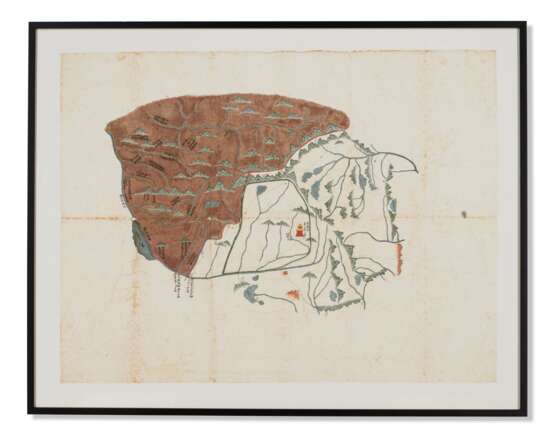ID 627600
Lot 111 | Chongjiao Temple by Jilin River on the China-Russian border
Estimate value
$ 2 000 – 3 000
Manuscript map of the Northwestern boundary between China and Russia determined in 1883 by the “Treaty of Khovd and Tarbagatai.” The map bonded on the west by the Irtysh River and on the east by the Altai Mountains is divided into two regions by a red diagonal line ending at the Alqabek River. This red line refers to the national boundary between China and Russia negotiated in 1883, as stated in the “Treaty of Khovd and Tarbagatai,” with the dark brown territory belonging to Russia and the uncolored section to Xinjiang, China. Within the dark brown terrain, a short red line is bifurcated from the 1883 border at the center of the map, demonstrating the old boundary set in the “Treaty of Khovd” in 1869, passing by the south side of Lake Zaysan. Under the “Treaty of Tarbagatai” signed by China and Russia in 1864, China ceded large areas of territory to Russia. In this map, some mountains, rivers and karuns (constructions for military defense) formerly belonged to the Qing court in Russian territory are annotated bilingually in Chinese and Mongolian characters. However, in the area of China, only a Chongjiao Temple (probably of Tibetan Buddhism based on its architectural style) and the Jilin River surrounding it have annotations. The temple is the most meticulously drawn element in the map, with three roads drawn as dotted lines in front of the temple leading to different directions. The usage of the map is possibly closely related to the temple. During the Qing dynasty, construction of Tibetan Buddhist monasteries in Xinjiang was a vital ethnic assimilation policy conducted by the Qing court.
Manuscript boundary map between Qing China and Russia, ink and colors on paper, within a modern black frame, approx. 680 x 890mm overall image. Mountains painted in green with dark green shades (two mountains in vermilion), rivers and lakes colored with dark green, national boundaries drawn out as red lines and roads as ink dotted lines; Qing dynasty military constructions rendered as two parallel uneven rectangles, those in the dark brown area are colored in dark green and those in the lower right area are left uncolored. Temple painted in ink, red and yellow. Vivid and crisp colors (two pea-sized holes at fold intersections, light foxing, heavier at folds). Float-mounted and framed (unexamined outside of frame).
Please note that this lot is subject to an import tariff. If the buyer instructs Christie’s to arrange shipping of the lot to a foreign address, the buyer will not be required to pay the import tariff. If the buyer instructs Christie’s to arrange shipping of the lot to a domestic address, if the buyer collects the property in person, or if the buyer arranges their own shipping (whether domestically or internationally), the buyer will be required to pay the import tariff. Please contact Post Sale Services on +1 212 636 2650 prior to bidding for more information.
| Artist: | William Shakespeare (1564 - 1616) |
|---|---|
| Applied technique: | Pencil |
| Artist: | William Shakespeare (1564 - 1616) |
|---|---|
| Applied technique: | Pencil |
| Address of auction |
CHRISTIE'S 8 King Street, St. James's SW1Y 6QT London United Kingdom | |
|---|---|---|
| Preview |
| |
| Phone | +44 (0)20 7839 9060 | |
| Buyer Premium | see on Website | |
| Conditions of purchase | Conditions of purchase |












